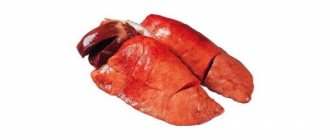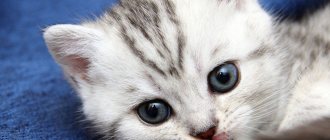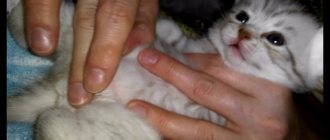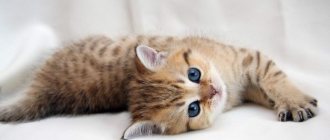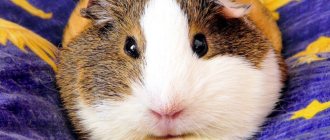Every day in the world is dedicated to some significant past events, people, heroes, discoveries. Such holidays are celebrated for the sake of memory, the transfer of certain experience to generations, and tribute to respect. There is also a holiday that honors pets: World Cat Day.
Why is a holiday dedicated to these fluffy and graceful creatures, and why is it celebrated in most countries of the world? The cat has been present in human life since ancient times. At different times, cats were credited with either medicinal or magical properties; at one time they were even considered the devil’s messengers.
global $ads_google; //data-ad-slot=”2475549904″ $ads_google = empty($ads_google) ? false : true; ?> if ($ads_google == false) {?> $ads_google = true; ?> } ?>
The modern world is grateful to these beautiful animals for the fact that they decorate our home, give a lot of warm and bright emotions, and protect our home from rodents. There is evidence that these animals treat many diseases, even save the owner from heart attacks. Therefore, it is not surprising that people willingly gave an entire calendar day to cats and cats as an honor and respect for these creatures.
history of the holiday
International Cat Day is a relatively new holiday. If World Animal Day was established back in 1931, the idea to celebrate Meowing Pet Day appeared only in 2002 thanks to the International Fund for Animal Welfare. August 8 was chosen as the date of the new holiday .
Since then, it has been celebrated in dozens of countries around the world. Interestingly, in some countries there are national holidays dedicated to cats, which fall on completely different days. For example, in Russia Cat Day is celebrated on March 1, because a meowing animal is associated with the arrival of spring; in the USA this day is celebrated on October 29, and in Japan on February 22. In Italy, only black cats are celebrated; their day is November 17, but all cats, without exception, can take part in the cat parade, which takes place on the second Sunday of May every three years in the Belgian town of Ypres.
On International Cat Day, animal shelters hold exhibitions where you can take your favorite kitten home for free, veterinary clinics host master classes on caring for cats, animal welfare funds hold charity events, and cat owners post photos with their pets on social networks.
Animals in the service of the state
In various countries, cats work alongside people:
- In Russia, it is customary to keep cats as museum guards. They protect expensive exhibits from the attacks of rodents, which with their sharp teeth can irrevocably damage expensive paintings.
- In Austria, cats protect grain warehouses. At the same time, every animal that has served for more than 10 years retires. Retired cats are maintained by the state.
- In Great Britain, cats are the guards of houses and government institutions from rodents. In England, the problem of a large number of mice is still acute, so the state is in great need of such furry guards.
Incentives. On cat day, “working” animals receive many different treats - selected meat and fish, milk and broths. The best and longest-working animals for the benefit of humans are awarded medals and regalia.
Also watch the World Cat Day video:
Why a cat is not just a pet
Once upon a time, cats were predatory and unapproachable, but after their domestication even before our era - 9500 years ago - a lot has changed! Today cats are the most popular pets and they are much more popular than dogs. According to statistics, more than 30 million cats live in Russian families - we rank third in the number of these purring animals in the world. And all because cats are unpretentious, they love to spend time on their own, but at the same time they are always ready to give warmth and affection to their owner. Research shows that interacting with cats can relieve physical tension, stress and improve health, including psychological health. A cat can provide emotional support to people suffering from depression, anxiety and loneliness.
It is also known that cats can relieve the owner’s physical pain - the normal body temperature of adult cats is from 37.5 to 38.9 ° C, so they are real “hot water bottles” for humans. You've probably noticed more than once that the cat itself determines where it hurts and applies its body to the source of the discomfort. Also, if a cat licks or fiddles with your ear, this is how she heals. The fact is that there are many acupuncture points on the auricle. By acting on them, a cat can prevent a heart attack or nervous breakdown.
Moreover, doctors from the Berlin Institute have proven that animal owners (including cats) live on average 10 years longer than people without pets.
May
Sunday through the first full week of May is National Pet Week in the United States.
May 3 is National Animals with Disabilities Day in the USA
May 8 is National Animal Disaster Preparedness Day in the United States.
May 30th is International Cuddle Your Cat Day.
How to celebrate Cat Day?
If you are the happy owner of a cat, you know exactly how to please your pet. This could be a favorite treat, a new toy, a cool bed or house. You can give your pet a collar with an “address” with your phone number - an invaluable thing for cats that love to walk outside or want to jump out the door.
It's great to spend time in nature on this day - just take care of a harness and leash in advance so that the cat doesn't get lost, or even stock up on a fashionable GPS tracker. Or you can carry out SPA treatments at home: comb the hair, comb out tangles, trim the nails if necessary. After such an event, you can arrange a photo shoot with a cat or even a party by inviting friends with their pets.
Those who have not yet decided to get a cat, but really love animals, can also spend Cat Day with benefit. For example, feed street kittens, go to the nearest cat cafe, or volunteer at a cat shelter. Maybe on this day you will decide and take one of the stray kittens home?
Poland
In Poland, Cat Day is celebrated on February 17th. The Poles have long been famous for their reverent attitude towards their four-legged friends.
Wanting to help our smaller brothers, the inhabitants of Poland established a cat day. Its main goal is to raise funds for donations to nurseries, as well as for medicine and sterilization of homeless animals.
Poles celebrate in a big way. Already in the early morning the main streets are closed and the fun begins. Exhibitions are organized, cat competitions, competitive events, colorful shows and festivals are held.
The “cherry on the cake” is a game of cat fun. Participants dress up in cat costumes and begin chasing huge balls of colored thread. This whole action looks very spectacular.
What should you not give to cats?
Even if you are ready to give your cat all the best and tastiest things you have, you shouldn’t overdo it! It turns out that there are foods that can not only disrupt digestion in cats, but even lead to death.
Milk. Unfortunately, you can watch a kitten lap up milk and be moved only when it is very small. Many adult cats, like humans, are intolerant to the protein casein or the sugar lactose found in cow's milk. Of course, milk contains many useful substances - proteins, vitamins, minerals - but compared to the problems that it can cause: from diarrhea to an acute allergic reaction, this is insignificant.
Coffee. Many cat lovers start their morning with two things: coffee and cuddling with their beloved pet. But keep in mind - it's best to do this one at a time: cats are more sensitive to the effects of caffeine than people. Coffee grounds are especially dangerous for cats - even a small amount can cause poisoning in adult animals and even lead to the death of a kitten. When taking coffee internally, signs of hyperactivity, rapid heartbeat, hypertension, tremors, vomiting, convulsions and other problems may occur.
Alcohol. Some cat owners like to indulge and offer their pet to try beer or wine at their leisure. This should not be done under any circumstances, because alcohol is harmful even to humans, not to mention pets. Cats are very sensitive to alcohol, and even a very small amount, such as one tablespoon, can lead to serious problems: problems with coordination, difficulty breathing, diarrhea and even depression.
Citrus. Oranges, tangerines, lemons and even kumquats can be great toys for your cat, but they are not food! The stems, leaves, peel, fruits and seeds of citrus plants contain citric acid and essential oils that can cause gastrointestinal irritation, diarrhea and even central nervous system problems.
Eggs. Some cat owners find it beneficial to give their animals raw eggs, as they are rich in vitamins, proteins and nutrients. But they can also contain salmonella and other parasites that can lead to pancreatitis, an inflammation of the pancreas. In addition, some enzymes contained in raw eggs can interfere with the absorption of B vitamins.
Raisins and grapes. Grapes and raisins are often given to pets, but in reality this is not a good idea at all. It turns out that grapes and raisins can cause kidney failure in some cats. Even a small amount of treats can make your cat sick.
Chocolate. It is known that many dogs love chocolate, but unlike them, cats usually avoid it. Apparently, they feel that they may have serious health problems. Chocolate contains a substance toxic to cats called theobromine , which is easily digested by humans, but cats digest it much more slowly, allowing it to accumulate to toxic levels in the body. This can cause them dehydration, abdominal pain, overexcitement, tremors, seizures and even death.
Innocent Victims: The Holy Inquisition and Modernity
The so-called “fight against heresy”, which was widespread in European countries during the heyday of the Holy Inquisition, accompanied by mass pogroms, legalized torture and public executions of many innocent people, is known to every history textbook. The past suffering of cats for the sins attributed to them by the Roman Catholic Church at a time when protecting animals became a fashionable trend is not often remembered.
In 1344, the French town of Metz was struck by an epidemic of chorea, a mental illness called the dance of St. Vitus, more than a thousand people “danced” in the streets for days on end and showed disorderly physical activity, allegedly caused by demons in cat form that had taken possession of them. The exact reasons for this phenomenon are still not known, but what happened then impressed the townspeople so much that over the next 400 years, residents of Metz celebrated Cat Day by annually burning 13 cats and cats in an iron cage in the main square.
The mass extermination of cats was started by Pope Innocent VIII himself, who declared in 1484 that cats are “ pagan beasts in league with the devil.”
" Church representatives explained to parishioners that “witches turn into black cats in order to do dark things under the cover of darkness and meet with the demon.” In this light, even the usual hunt of cats for mice began to be interpreted as nothing other than the devil’s hunt for human souls. So in Western Europe, difficult times came for cats, when the torture and destruction of “satanic spawn” by conscientious citizens became legalized and commonplace. No one could have imagined that several centuries later International Cat Day would be established.
The love of felines for night walks, their silent steps and pupils glowing brightly in the dark played a cruel joke on cats. They were everywhere, without trial or investigation, drowned in sacks, strangled, quartered, burned in cages made of willow twigs, thrown from towers and high walls. Of course, black cats got it more than others. Only a white spot on the fur could save a black cat from imminent death, which was often interpreted as the “mark of an angel”, capable of ridding the animal of suspicions of witchcraft.
Looking through online publications about the times of cat genocide, I have repeatedly come across the opinion that the almost complete destruction of urban cats in the Middle Ages was one of the reasons for the spread of the plague, brought with rats to European port cities by merchant ships. There was no one left to fight the rapidly growing populations of disease-carrying rodents in cities, and the epidemics that struck cities one after another became a punishment for human stupidity and hard-heartedness.
In Western Europe, almost everywhere, cats have become victims of prejudice and cruel traditions. For example, in Pomerania and Bohemia they were buried in the fields to “protect” the crop from pests. In England, live cats were walled up in the foundations of buildings to prevent mice and rats from living in the premises. During the reconstruction of the Tower of London, a dried up and mummified cat was found, which was embedded in the stonework by the builders.
The well-deserved love for cats returned only during the Renaissance; the animal again attracted close attention - this time from scientists, artists, sculptors, and writers. Then the man actively began breeding new breeds of cats, of which more than a hundred have now been officially registered.
The Slavs were generally more loyal and humane to cats than enlightened Europeans. In Rus', since the 12th century, cat breeding has become the order of the day. The Orthodox Church, unlike the Catholic Church, even took animals under its protection, using them to save their own bins from rodents. Soon cats began to live not only in church barns, but also in rural huts, and in the chambers of boyars and royals. Cats, as in Ancient Egypt, among the ancient Slavs became patrons of the hearth, and the custom arose of letting a male cat into a new home first. The cat in Rus' was both a storyteller-bayun, calming and putting little children to sleep, and a healer, saving from illnesses and evil spirits. It was believed that a person who killed a cat would have no luck for 7 years. Many proverbs related to these animals have appeared in the Russian language, which can be discussed in a separate article.
But enough about the past and dark times. Let's remember our past, still living in memory, and at the same time talk about the present. What in fact is World Cat Day, celebrated annually today in many countries - an attempt to atone for long centuries of torture, another “holiday for show,” a farce, or a sudden awakening in a person of love for our smaller brothers?
After all, if we strain our memory a little, many of us will recall stories we have seen or heard from someone about cruelty to cats. In my rural childhood, a traditional bucket of water awaited the litter of kittens in almost every yard, and this was an everyday occurrence, a necessity and the norm. In my urban childhood, teenagers my age tied tin cans to cats’ tails and threw these animals from the roofs of high-rise buildings, which were then freely accessible. Yes, such cases were rare, they were clearly condemned by the public, but they did exist.
How much have we moved forward from the ruthless and indifferent to the suffering of the inhabitants of medieval Europe? If we talk about today, you don’t have to look far for examples - in the media every now and then there are reports of ritual sacrifices, burning of cats and abuse of them.
A separate topic is cooking. Until recently, cat meat was widely consumed in some Asian countries, in particular China and Vietnam. And Yandex suggests that there are many people among us who want to learn how to cook cats correctly - queries are entered into the search bar hundreds of times a month: cat dishes, cat dishes recipes with photos, cat dishes in Moscow. It would be funny if it weren’t for the search results for these queries, which are far from humorous.
During its centuries-long cohabitation in the same territory with “Homo sapiens,” the cat suffered enough from him. But it is also necessary to recognize that both in the past and in the present, cats have had and still have not only ardent opponents and haters, but also people who belong to the cat tribe in a friendly, loving manner. It is difficult to say what determines the relationship between a person and a cat. It seems to me that this depends on the global internal attitudes of each individual - on who he feeds and nurtures within himself - the demons of greed and violence or the spirits of kindness and compassion for all living things.
Lebanese Fried Chicken with Mint Sauce
Ingredients:
For chicken: 1 whole chicken 1 lemon 1 tsp. cumin 1 tsp. paprika 1 tsp. coriander seeds 1 tsp. chili pepper 1 tsp. ground cinnamon 2 tablespoons olive oil
For the sauce: 1 tbsp. olive oil 300 ml natural Greek yogurt 5 sprigs of cilantro 5 sprigs of mint 2 tbsp. viscous honey
How to cook:
- Mix cumin, paprika, coriander, chili, and cinnamon in a mortar. Grind thoroughly and add salt.
- Pour lemon juice and olive oil into the spices. Mix and set aside to brew.
- Rub the chicken with spices and leave in the refrigerator for 2-3 hours.
- Preheat the oven to 200 degrees and place the chicken for 40 minutes.
- Meanwhile, prepare the sauce. Chop the cilantro and mint leaves.
- Mix yogurt, herbs, olive oil and honey. Add salt and black pepper to taste.
- Place in the refrigerator.
- Serve the hot chicken with the cold sauce over it.
Heroes of our time
In Russian regional newspapers one can find many examples of how “friends of man” confirm their noble status with specific actions. And sometimes they become not just friends or helpers, but truly benefactors and even rescuers. These examples mostly involve dogs. Textbook stories: a border guard dog, a police dog, a guide dog, a diver dog, or even cooler: a kamikaze dog with a bomb on its back diving under an enemy tank... There are no cats in such stories. But not completely, they also have some similar plots. Let's look for them on the pages of regional publications, partners of Rossiyskaya Gazeta.
Let's start from afar. From distant Japan. The Republican publication Grozny Inform reported an amazing fact. The Toyama City Police Department appointed a cat named Coco as its chief officer for one day as a sign of respect and recognition. “Last summer, a local resident, while walking, noticed a cat staring intently in the direction of one of the city’s irrigation canals. Following the direction of the animal’s gaze, the woman realized that the cat was watching the man, who was lying unconscious at the bottom of the canal and at risk of choking. Through the joint efforts of local residents, the man was saved. And the police awarded the savior a special award: they accepted her into their ranks. But not without humor: just for one day. “And henceforth I solemnly promise to be vigilant during my walks,” says the text of the oath, on which a cat in a police uniform stamped her paw.
As you can see, a cat can serve a person no worse than a dog.
Beautiful is the one who is loved
Not so long ago, inhuman passions were in full swing in Irkutsk. The competition for the most beautiful cat has opened! The owners of their beloved pets enthusiastically joined the competition. “Among the meowing contestants there are plump ones, non-pedigree ones, and those with character,” comments the Irkutsk newspaper. A Sphynx cat with the strange name Shkidla Kusechka made it into the top ten. Her owner Yana Lisitsyna told a lot of interesting things about her beloved pet.
“Once I was walking down the street and saw a sphinx cat of incredible beauty in the window of a wooden house, and next to it was an advertisement “We are giving away kittens.” As it turned out, there was only one left - a small, fragile, gray lump. I paid 30 rubles for it and took it home. We began to nurse her, feed her, and specially made a small “pen” in the apartment, but this baby immediately got out of there and proved that she was a completely viable little monster. Very soon we realized: it is not necessary to save her, but to save ourselves. Due to her hooligan character and brutal appetite, the nickname Shkidla Kusechka immediately stuck to her.”
One day Shkidla Kusechka entered the closet, pulled out five pairs of socks, overturned a laundry basket in the bathroom, dropped a heavy chair on cups of cat food in a swift jump, and climbed the curtains as if on ropes. She liked all this so much that she began to practice such manipulations constantly. “Well, what can you do - there’s a child in the house! - the hostess says tenderly. “And we sent it to the competition as a symbol: “Favorite means beautiful.” Regardless of breed, purebred, color or manners.”

